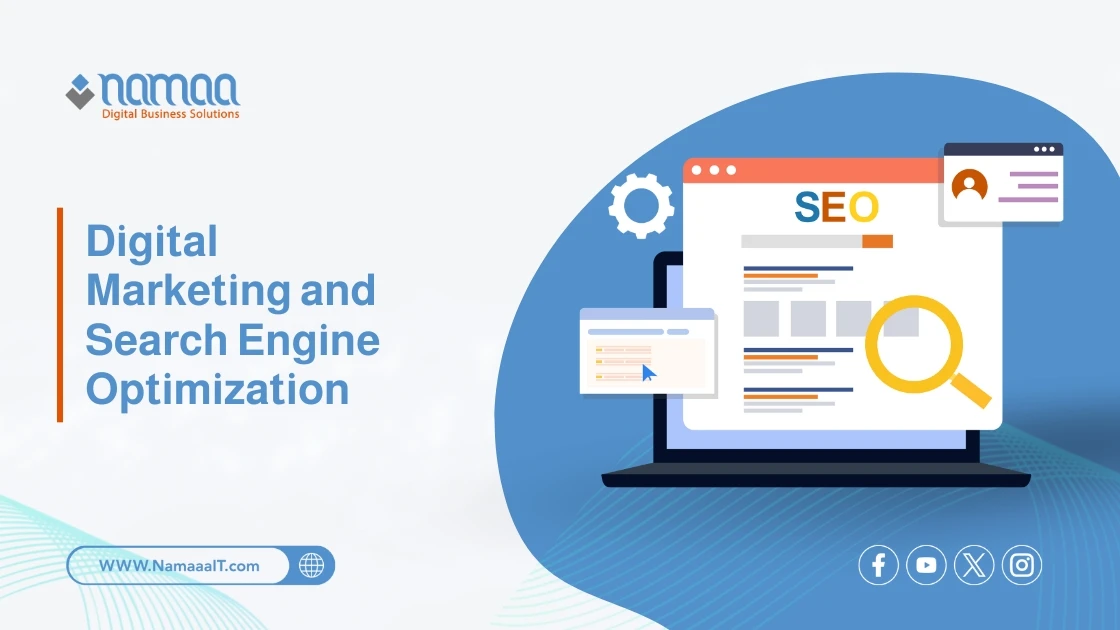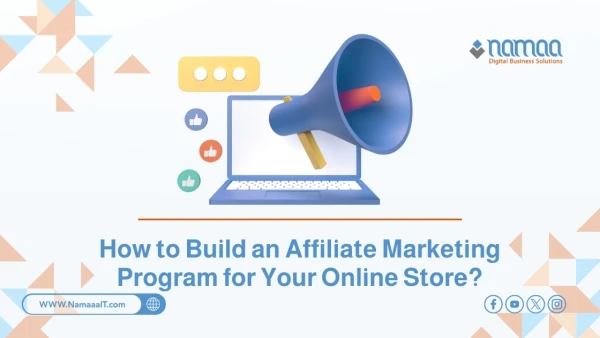Having a strong online presence has become essential for the success of businesses of all sizes. It requires more than just creating a website or social media accounts. These digital assets must be visible and attractive to potential customers, ultimately converting them into actual clients. Digital marketing and search engine optimization (SEO) are fundamental tools in achieving this goal and effectively reaching the target audience.
In this article, we’ll explore the complementary relationship between these two fields and how a well-planned strategy combining both can drive sustainable business growth. We will cover the definition and importance of each, how they work together to achieve comprehensive marketing goals, and share insights into best practices and future trends in the ever-evolving digital landscape.
What Is Digital Marketing and Why Is It Important in the Digital Age?
Digital marketing (E-marketing), also known as online marketing, is simply the use of digital platforms and channels to promote products, services, or brands and connect with current and potential customers. It is a broad umbrella that includes a variety of tactics and strategies carried out online.
Key Components of Digital Marketing:
- Search Engine Marketing (SEM): Includes both SEO (organic results) and paid advertising (PPC).
- Content Marketing: Creating and distributing valuable, relevant content to attract and retain a clearly defined audience.
- Social Media Marketing: Using platforms like Facebook, Instagram, Twitter, and LinkedIn to engage, build relationships, and increase brand awareness.
- Email Marketing: Sending promotional and informational messages directly to a subscriber list.
- Affiliate Marketing: Partnering with individuals or companies to promote your products in exchange for a commission.
- Paid Advertising (PPC): Displaying ads on search engines, social networks, or other websites and paying per click or impression.
- Influencer Marketing: Collaborating with influencers to reach a broader audience.
Why Digital Marketing Matters:
In a world where internet users are growing daily, digital marketing offers unmatched advantages over traditional marketing:
- Wider Reach: Access a global audience at a much lower cost.
- Precise Targeting: Reach specific audience segments based on interests, behavior, and demographics.
- Measurable Results: Digital tools provide accurate data for continuous campaign improvement.
- Direct Engagement: Build strong relationships with customers through ongoing interaction.
- Cost-Effective: Often more affordable than traditional methods with higher return on investment (ROI).
- Flexibility and Speed: Campaigns can be adjusted quickly based on results or market changes.
What Is Search Engine Optimization (SEO)?
Search Engine Optimization (SEO) is the process of improving your website’s visibility in the organic (non-paid) results of search engines like Google or Bing. The main goal of SEO is to increase both the quantity and quality of website traffic by understanding how search engines work and what users are searching for.
How Search Engines Work:
To understand SEO, it's important to know how search engines operate. They follow three main steps:
- Crawling: Bots (called spiders or crawlers) explore the web to find new or updated pages.
- Indexing: The content is analyzed, organized, and stored in a huge database known as the index.
- Ranking: When a user performs a search, search engines analyze the index and present the most relevant and valuable results using complex algorithms.
SEO Goals:
- Increase Visibility: Get your site to rank at the top of search results for keywords relevant to your business.
- Drive Targeted Traffic: Attract users actively searching for the products, services, or information you offer.
- Build Trust and Credibility: Top-ranking sites are generally seen as more trustworthy.
- Improve User Experience (UX): Good SEO involves improving website structure, speed, and usability—benefiting all visitors.
- Achieve Sustainable ROI: Unlike paid ads, organic traffic from SEO continues without direct cost per visit.
How SEO Supports Digital Marketing Goals
SEO and digital marketing are not separate entities—they are two sides of the same coin. SEO is one of the most vital components of a comprehensive digital marketing strategy, playing a key role in enhancing other marketing efforts.
How SEO Integrates with Digital Marketing:
- Attracts Qualified Traffic to Content: Great content needs SEO to reach its target audience through organic search.
- Provides Valuable Targeting Data: Keyword research and organic analytics reveal user intent and behavior, informing other campaigns (e.g., social media, PPC, email).
- Boosts Brand Credibility: Consistent high rankings build trust, benefiting all other marketing channels.
- Enhances UX Across Channels: SEO-driven improvements like speed and mobile optimization help all users, no matter how they reach your site.
- Improves Content ROI: SEO ensures content is discoverable long-term, offering more value than short-lived paid promotions.
- Supports Paid Advertising Campaigns: SEO data can inform PPC campaigns, and strong organic presence boosts overall click-through rates (CTR).
Effective Content Strategy and Its Role in Digital Marketing & SEO
Content is the fuel that powers both digital marketing and SEO.
You can’t rank in search engines without high-quality content, and you can’t run effective marketing campaigns without compelling messages and content.
Why Content Is So Important:
- Answers Audience Questions: Valuable content provides the information users are looking for, building trust and authority.
- Targets Keywords: Content is where you embed the keywords you want to rank for.
- Attracts Backlinks: Exceptional content (like original research, comprehensive guides, or free tools) naturally earns backlinks.
- Keeps Visitors Engaged: Engaging content increases time on site, signaling quality to search engines.
- Supports Every Stage of the Customer Journey: Different content types meet user needs during awareness, consideration, and decision stages.
- Fuels Social Media & Email Marketing: Content provides valuable material to share across other marketing channels.
Top Tools for Digital Marketing and SEO
Navigating digital marketing and SEO effectively requires a toolkit for research, analysis, execution, and measurement. Tools are categorized as follows:
Keyword Research Tools:
- Google Keyword Planner: Free tool from Google for basic ideas and search volumes.
- SEMrush, Ahrefs, Moz Keyword Explorer: Paid tools with detailed insights on keyword difficulty, search volume, and content ideas.
Analytics & Site Monitoring:
- Google Analytics: Free essential tool to track traffic, user behavior, sources, and conversions.
- Google Search Console: Free tool to monitor search performance, fix technical issues, and submit sitemaps.
SEO Analysis Tools (On-Page & Off-Page):
- Screaming Frog SEO Spider: Desktop crawler for technical and on-page SEO audits.
- Yoast SEO / Rank Math (for WordPress): Plugins that make on-page optimization easy.
- Ahrefs, SEMrush, Moz Link Explorer: Robust tools for analyzing backlinks (yours and competitors').
Content Marketing Tools:
- BuzzSumo: Discover trending content and influencers in your niche.
- Grammarly: Grammar and spelling checker to enhance writing quality.
Social Media Marketing Tools:
Hootsuite, Buffer: Manage and schedule posts across multiple platforms.
Email Marketing Tools:
Mailchimp, Constant Contact, GetResponse: Create, manage, and automate email campaigns.
Competitor Analysis Tools:
- SimilarWeb: Estimate traffic and sources for competitor websites.
- SEMrush, Ahrefs: Analyze SEO and PPC strategies of your competitors.
read more: Top 10 Features Your Company Website Must Have
The Future of Digital Marketing & SEO
The digital landscape is constantly evolving, and businesses must adapt to stay ahead. Here are some key trends shaping the future:
- Artificial Intelligence (AI): AI will impact everything from keyword research and content creation to user experience and search engine algorithms (like Google RankBrain and BERT).
- Voice Search: With the rise of Siri, Alexa, and Google Assistant, content needs to answer questions in natural language and target long-tail keywords.
- Video SEO: Video content is booming. Optimizing titles, descriptions, tags, and transcripts is crucial for ranking in video search.
- User Experience (UX): Google increasingly values UX metrics like Core Web Vitals (load speed, interactivity, and visual stability).
- E-A-T (Expertise, Authority, Trust): Google prioritizes high-quality, credible content—especially for topics impacting people’s lives (YMYL).
- Local SEO: Vital for businesses with a physical presence. Optimizing your Google Business Profile and collecting local reviews are key.
- Data Privacy & Cookieless Marketing: With stricter privacy laws and the decline of third-party cookies, focus is shifting to first-party data and direct customer relationships.
- Visual Search: Tools like Google Lens and Pinterest Lens allow users to search via images—opening up new opportunities for image optimization.
Summary
✅ Digital marketing is essential for broad online reach, while SEO is a core tool for attracting high-quality, targeted organic traffic, often accounting for more than 50% of total website visits.
✅ SEO and digital marketing work hand in hand. SEO increases content visibility and supplies valuable user behavior data to refine other campaigns (e.g., ads, social media), maximizing overall ROI.
✅ High-quality content is the cornerstone, and should be optimized based on the three SEO pillars: on-page, off-page, and technical, ensuring keyword targeting, link-building, and exceptional UX.
✅ Performance measurement is critical, using KPIs like organic traffic volume, keyword rankings, and conversion rates—tracked through tools like Google Analytics and Search Console—for continuous, data-driven improvement.
✅ The future leans heavily on AI, voice and visual search, and UX as success determinants, requiring businesses to embrace more than five major technological and behavioral trends to stay ahead in the digital game.




.webp)
.webp)


